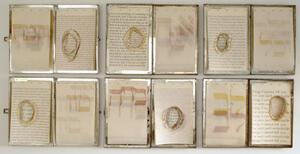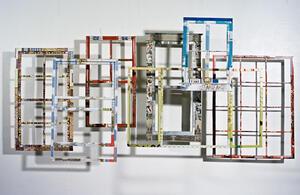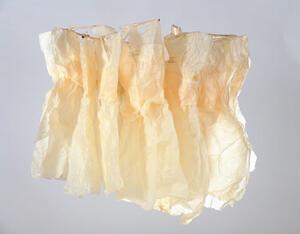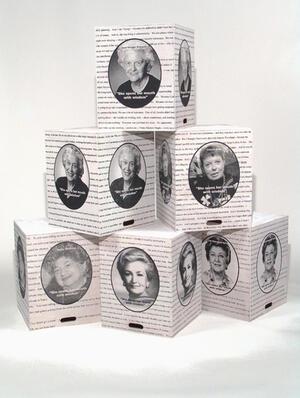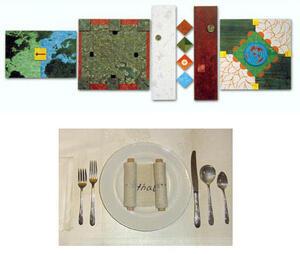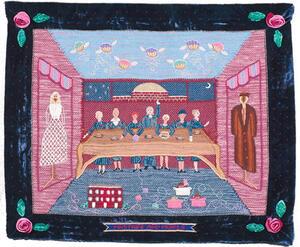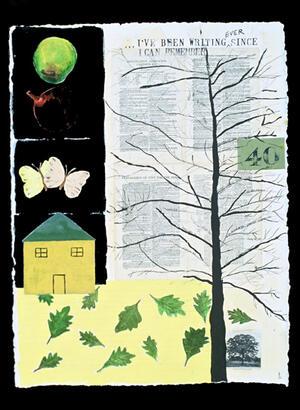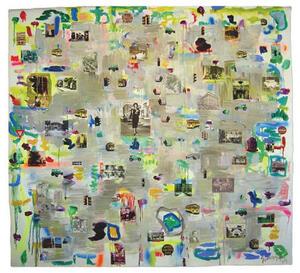Participating Artists
Meet the Jewish women who worked as artists, educators, and advocates and who immeasurably enriched Baltimore's cultural life.
Lynne Avadenka, Huntington Woods, MI
Lynne Avadenka states, “I am an artist for whom words are inseparable from images. The ongoing theme in my work is communication, both visual and through text. The work is about reading and seeing on multiple levels: it is concerned with the narrative and the element of mystery that allows the reader/viewer to participate. A crucial element of my work has been to explore traditional Jewish subject matter and to place that subject matter in a contemporary context. The challenge is to create synthesis, inspired by tradition and informed by modernity. Using the idea of the book as a starting point, I draw upon my skills as a printmaker working in multiples, a calligrapher concerned with letter forms and a bookbinder building structures.”
Lynne Avadenka has been awarded grants for her work from the National Endowment for the Arts, The Michigan Council for Arts and Cultural Affairs and the Women’s Studio Workshop. In 1998 Avadenka was awarded the first Maas Prize, established to honor excellence in the arts and humanities in Detroit Jewish life. Avadenka’s work is included in the following selected institutions, as well as private collections: The Library of Congress, Washington DC, The Jewish Museum, NY, The Israel Museum, Jerusalem, Israel, The Detroit Institute of Arts, Detroit, MI, The New York Public Library, NY, the Getty Research Center, CA. She lives and works near Detroit, Michigan.
Harriete Estel Berman, San Mateo, CA
Harriete Estel Berman’s Artist Statement for her Judaica states:
“Making Judaica has been my means of personal observance and interpretation. The construction of my Judaica from recycled tin cans and steel dollhouses seeks value in reused material. By reclaiming from the over-abundance of our consumer society, we renew hope for the future. As both a manifestation of our contemporary culture and a reflection of our past, the images evoke memory, imparting value outside of precious materials. Like touching heirlooms or viewing old photos, observance and tradition echo meaning in contemporary Judaica (and we) touch this connection to our history.”
Berman has a Masters in Fine Art from the Tyler School of Art at Temple University and her undergraduate degree from Syracuse University. She lives in San Mateo, CA.
Carol Hamoy, New York, NY
Carol Hamoy’s Artist Statement includes the following description:
As in all her work, Carol Hamoy’s themes blur the distinction between autobiographical narrative and general social commentary. Most often her subjects are issues of central importance to women, both past and present. What Hamoy is discussing is beyond gender and politics. It deals more with being a person in a group where shared sameness promotes a level of understanding, compassion, tolerance and generosity.... The power of her work lies in the universality of the issues addressed and her dignified, respectful and affectionate presentations. Hamoy’s Welcome to America exhibition has traveled extensively throughout the U.S. She lives in New York City.
Leslie Golomb Hartman, Pittsburgh, PA
Leslie Golomb Hartman states, “My father started a second career when I was a small girl. He enrolled in night school at a local art college. I was lucky; he took me with him. He bought me my own box of pastels and it was as though I had been given a box of gold. I have never taken for granted that I was given this gift or the permission to make art. Although art tends to be a solitary act, I do not allow myself to be isolated. Art is meant to be a dialogue. My art serves as a vehicle for positive social change.”
Hartman received her MFA from the School of the Art Institute of Chicago and BA from Carnegie Mellon University. She is presently the director of the American Jewish Museum at the Jewish Community Center of Pittsburgh where she has initiated many exhibitions exploring contemporary meaning in Jewish art. Her own artwork has been shown in many exhibitions and she has received such respected awards as the Jurors Choice of the Textile Museum in Washington DC and the Vira Heinz Award from the Carnegie Museum of Art. Her work is held by many private and corporate collections.
Bonnie Lee Holland, Bethesda, MD
Bonnie Lee Holland’s artist statement includes the following description:
“I now work in many two and three-dimensional formats using pigments on paper and canvas, dye painted silk with resists and mixed media. Formats include wall pieces, banners, wearable art, hand scrolls, and installations among others. The scrolls, art books, sculpture, and installations involve themes on process, change, metamorphosis, transformation, growth, internal and external journeys and non-static portraits. In all my work, I see the meaning as not just my intent, or what I see happening in the dialogue in the making of the work, or in the future when I look at the work, but also what viewers bring to the work which makes the work resonate differently for each person.”
Holland has an AB degree from Washington University, a MA from George Washington University (when it was affiliated with the Corcoran School of Art), and also studied at the School of the Art Institute of Chicago. She lives in Bethesda, MD.
Wendy Jachman, Baltimore, MD
Wendy Jachman writes in her artist’s statement that she has been weaving and employing various textile techniques in her artwork for the past 30 years. Her early weaving and textile pieces were less narrative and more decorative. Her work has evolved into large tapestries and she has recently completed a tapestry for the Freeman Center for Jewish Learning at Duke University on the seven days of creation. Jachman’s work is in many private collections and she has been featured in exhibitions throughout Baltimore and at galleries in New York and Florida. She lives in Baltimore, MD.
Viviana Lombrozo, San Diego, CA
Viviana Lombrozo writes: “I have always been fascinated by the role that memories play in personal and collective identity. A ‘container of memories’ can become my vehicle for observing, cataloguing and examining personal recollections which allow me to connect past, present and future.”
Lombrozo, originally from Mexico, has lived in San Diego for the past twenty years. Her versatile styles range from installations and paintings to book art. Development of her themes ranges from the very literal use of Judaica in works which deal with domestic and liturgical spaces to abstract representations of courage based on personal interviews of Spanish-speaking Holocaust survivors.
Rhoda London, Portland, OR
Rhoda London’s Artist Statement includes the following description of her work:
“I am a painter and installation artist. My work concerns the environment, immigration (displacement and adaptation), women and art history, gender issues and relationships, and currently, the complications of memory. In the area of women’s issues, my interests are the rights of women, the stories, histories and lives of women. In a recent installation for woman house, I explore a more personal issue—how memory shapes and restricts our lives. Knotted memories is about the ability to revive impressions and recall past experiences in order to reclaim identity and understand the self. I like to work with a layering of ideas and different materials that are appropriate to the subject. My concerns for the poetry, the beauty and the mystery of life, people and what makes them behave are what makes me insistent about art making. My own history, beliefs, attitudes, desires and dreams are the strength of my art making.”
London received her MFA from the California College of Arts and Crafts and in 1999 was the recipient of a California Arts Council Visual Artist’s Fellowship. She presently lives in Portland, Oregon.
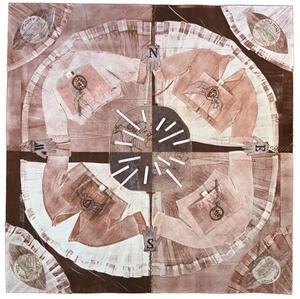
The Circle Holds the Story, by Debra Olin. Monoprint collage on paper and muslin
83" x 84."Quotation reprinted from Little New Angel by Sadie Weilerstein, © 1947, The Jewish Publication Society with permission of the publisher, The Jewish Publication Society
Photograph by Bill Kipp, courtesy of Debra Olin.
Debra Olin, Somerville, MA
Debra Olin’s work explores identity, history and language through rich imagery. While her work may hang on a wall, it is almost three-dimensional through the use of pleating, construction, and garment-like surfaces. “Her garments are containers for questions about identity, specifically Jewish identity,” said a review in the Boston Globe. An example of the narrative behind one of her pieces is her memory that her grandparents never talked about their lives in Europe. Yet her art is an exploration of their lives before America. She prints clothing, developing visual texture with passports, photographs and the repeated uses of Yiddish words.
Olin received her MFA at Massachusetts College of Art and her BA at the University of Cincinnati. She has shown in exhibitions across the United States, South Africa and Cuba. Her work is in the permanent collections of the Boston Public Library, Temple Israel in Brookline, MA, YIVO Institute, and the Fogg Art Museum of Harvard University. Debra was recently awarded the Rappaport Prize, the largest public annual award to an individual artist in New England.
Tammra Sigler, Baltimore, MD/Naples, FL
“My recent work is more relaxed with an ease of style and attitude. There is a stream of consciousness, an overlay of ideas. Images float, land, and converge. These paintings deal with the multiple and complex stimuli that make up each moment. I explore the confusion and the order of our lives. By standing back far enough, rhythms and patterns emerge. We can then perceive the over-all order.” Sigler’s work has been featured extensively in exhibitions nationally and internationally, as well as throughout the Baltimore/Washington and Naples, Florida areas. In addition to many public and private collections, her work is part of the permanent collections of the National Museum of Women in the Arts, and The Baltimore Museum of Art.
Sigler studied at Syracuse University School of Fine Arts, and received her BFA with honors in painting from the Maryland Institute College of Art in Baltimore.
Robbin Ami Silverberg, Brooklyn, NY
Robbin Amy Silverberg is a “book artist” whose work is hardly restricted to the immediate image that the word “book” evokes. Her books are often made of cloth, a fabric intimately associated with text, are part construction, sometimes without words and always visually engaging and intriguing. Her books often require opening, pulling, lifting and then, reading. The materials are tactile and the very engagement of the viewer with the book forces the viewer to be aware of even minute movements. As Silverberg says of her own work, “I never wanted to make books; I wanted to sculpt with paper. Books are a potent form; they are the containers of our culture and civilization.”
Silverberg’s work is all over the globe—from Guadalajara to Budapest and points throughout the United States and in between. She runs a hand papermaking studio in Brooklyn and has run paper and book art workshops at art schools throughout Canada, South Africa, Hungary and the United States. She studied at the School of the Museum of Fine Arts in Boston and has her BA in art from Princeton. She presently lives in Brooklyn, NY.

